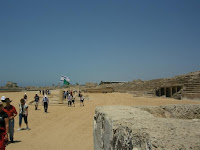On Israeli Independence Day, we walked in the old city. It was a moving experience, One I will not forget in a while.
It started overlooking Hell – Literally. I’ve now seen the Valley of Hinom, where there were temples to Molech and where, as we read in several places in Leviticus and Kings, children were sacrificed in pagan rites by being burned alive. King Hezekiah finally put an end to such horrible practices. On mount Zion we saw the tomb of King David and the place where the last supper was held. Walked from there into the old city, through the crowded markets, which was quite the experience.
At the end of this walk we came to the western wall. As we waited for the group to get through Security, the Israeli version of the Blue Angels flew overhead, involved in acrobatic displays for Independence day.
My dove in concealment of the cliff,
In steep hiding places
Show me your appearance,
Let me hear your Voice
For your voice is sweet
And your appearance beautiful [Song of Songs 2:14]
There have been many interpretations of that verse. The traditional interpretation describes it as God talking to Israel at Sinai. I’ve believed it is God pleading with Man to pray with Kavvanah. But when I opened my tear filled eyes, I had another interpretation. On the upper parts of the kotel there are doves nesting, turtle doves and even a few white doves. They cling to the wall as their home, and hide in the cracks of this rock. Birds were nesting everywhere on the wall actually: the more I looked the more birds I saw. I had not noticed them before, maybe now I will. I had asked my eyes to be opened, and here was sign that they had. It was an intense moment.
From there we walked through the crowded Arab quarter to being our trek on the Via Della Rosa, the path Jesus took from his capture to his death and burial, ending at the Church of the Holy Sepulcher. Being here there is a reversal from the wall. While a Christian would not find the wall important, I found it full of faith. Now the roles were reversed, and I could dispassionately observe what I felt at the wall in others, as they kiss the stone where the cross has been put into the ground. Faith is a powerful thing, it’s just sad that faith through history is often twisted by leaders in their lust for power. Being in this place so often conquered since the time of David and still under contention, I wonder that a lot. I keep asking why we fall to such people, like Hitler as I saw I Yad V’shem.




